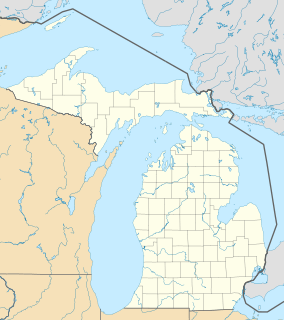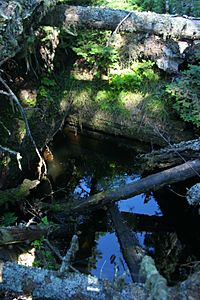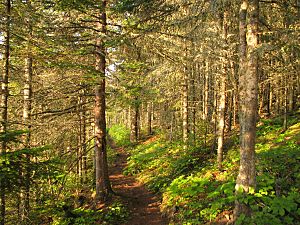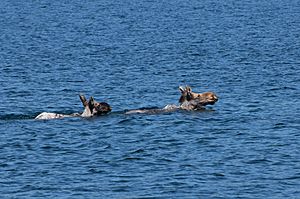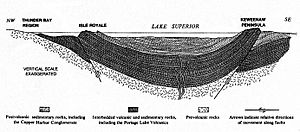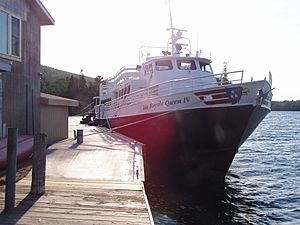Isle Royale National Park facts for kids
Quick facts for kids Isle Royale National Park |
|
|---|---|
|
IUCN Category Ib (Wilderness Area)
|
|
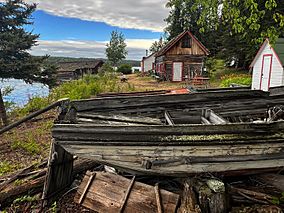
Site of the historic Edisen Fishery
|
|
| Location | Keweenaw County, Michigan, United States |
| Nearest city | Thunder Bay, Ontario |
| Area | 571,790 acres (2,314.0 km2) |
| Established | April 3, 1940 |
| Visitors | 28,965 (in 2023) |
| Governing body | National Park Service |
| Website | Isle Royale National Park |
|
Minong
|
|
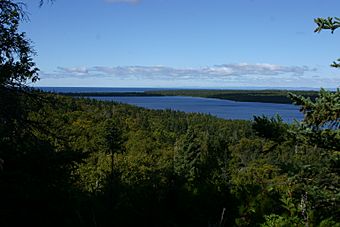
Siskiwit Bay
|
|
| Area | 189,665 acres (76,755 ha) [133,788 acres (54,142 ha) land and 55,877 acres (22,613 ha) water] |
|---|---|
| NRHP reference No. | 100003341 |
| Added to NRHP | January 24, 2019 |
Isle Royale National Park is a special place in the United States. It's a national park made up of a big island called Isle Royale. It also includes over 400 smaller islands and the water around them in Lake Superior, which is in Michigan.
Isle Royale is about 45 miles (72 km) long and 9 miles (14 km) wide. It covers about 207 square miles (536 km²). This makes it the fourth-largest island in any lake in the world! It's also the biggest natural island in Lake Superior.
This park was created on April 3, 1940. Later, in 1976, it became a protected wilderness area. This means it's kept wild and natural. In 1980, UNESCO named it an International Biosphere Reserve. This shows it's important for nature worldwide. In 2019, it was added to the National Register of Historic Places. This recognized its long history and culture. The park covers about 894 square miles (2,315 km²). Most of this is water (685 sq mi or 1,774 km²), with 209 square miles (541 km²) of land.
The northern edge of the park is right next to Canada. It's near the Lake Superior National Marine Conservation Area. Isle Royale National Park is one of the least visited national parks in the United States. In 2021, about 25,894 people visited it.
Contents
Exploring Isle Royale's Geography
Isle Royale is the largest island in Lake Superior. It is over 45 miles (72 km) long and 9 miles (14 km) wide at its widest part. The park includes Isle Royale itself and about 400 smaller islands. It also covers the water up to 4.5 miles (7.2 km) around these islands.
The highest point on the island is Mount Desor. It stands at 1,394 feet (425 m) high. That's about 800 feet (244 m) above the lake's surface.
Isle Royale is about 15 miles (24 km) from the Canadian shore. It's also near Minnesota, close to the city of Thunder Bay. It's much farther from the Michigan shore, about 56 miles (90 km) away.
There are no roads on the island. You can't use cars or bikes, except for wheelchairs. At Rock Harbor, you can use wheeled carts to move your things. Park staff use tractors and utility vehicles in certain developed areas.
The soil on the island is usually thin. This helps trees with roots that spread out, like balsam fir and spruce trees.
Lakes Inside the Island
Siskiwit Lake is the biggest lake on Isle Royale. Its water is cold, clear, and doesn't have many nutrients. Siskiwit Lake has several islands within it, including Ryan Island, which is the largest.
Other lakes on the island include:
- Chicken Bone Lake
- Lake Desor
- Feldtmann Lake
- Intermediate Lake (Isle Royale)
- Lake Ritchie
- Sargent Lake
Isle Royale's Climate and Weather
Isle Royale National Park has a climate with mild summers. This means it gets warm, but not too hot, in the summer. The winters are cold.
There isn't a weather station right in the park. Scientists use information from nearby areas to understand the island's weather.
Here's a quick look at the average weather:
- Winter (Jan-Feb): Cold, with average temperatures around 8-14°F (-13 to -10°C).
- Spring (Mar-May): Gets warmer, with averages from 24-47°F (-4 to 8°C).
- Summer (Jun-Aug): Mild and pleasant, with averages from 56-62°F (13 to 17°C).
- Fall (Sep-Nov): Cools down, with averages from 53-28°F (12 to -2°C).
The island gets about 30 inches (76 cm) of rain and snow each year. It's also quite humid, especially in winter.
Isle Royale's Long History
Ancient Times and Copper Mining
For thousands of years, native people from Minnesota and Ontario used Isle Royale as a hunting ground. They would travel about 13 miles (21 km) by canoe to reach the island.
Many copper tools and items have been found in ancient settlements. Some date back to 3000 BC! It's believed this copper came from mines on Isle Royale and the nearby Keweenaw Peninsula. The island has hundreds of old pits and trenches dug by these early people. Some are as deep as 65 feet (20 m). Most are in the McCargoe Cove area. Tests show that some wooden tools found in copper mines are at least 6,500 years old.
In the 1600s, a missionary named Dablon wrote about an island called Menong. He said it was famous for its copper. Menong or Minong was the native name for the island. This name is still used for Minong Ridge.
In the mid-1800s, more modern copper mining began. Miners found many old pits and tools left by native people. These old sites helped them find new copper deposits. However, the island was far away, and the copper veins were small. So, most of these mines didn't last long.
During the late 1800s, miners and loggers cut down many trees on the island. But when it became a national park in 1940, logging stopped. The forests then started to grow back.
Fishing and Lighthouses
Isle Royale used to have several places where people fished for lake trout and whitefish. There were also a few resorts. The fishing industry has become much smaller now. However, fishing still happens at places like Edisen Fishery.
Today, no one lives on the island all year round. The small communities of Scandinavian fishermen were moved by the National Park Service in the 1940s. But about 12 families still have special permission to use their cabins for life. They see Isle Royale as part of their family history. Some of their descendants still fish in the waters around the island.
Many small islands surround Isle Royale. So, lighthouses were built to help ships. These include lighthouses at Passage Island, Rock Harbor, Rock of Ages, and Isle Royale Lighthouse.
The western tip of the island has several shipwrecks. These are very popular with scuba divers. One famous shipwreck is the SS America. The park has mapped 10 of the most famous shipwrecks. The cold, fresh water of Lake Superior helps keep these wrecks in good condition.
In 2019, the entire island chain was added to the National Register of Historic Places. It's known there as 'the Minong Traditional Cultural Property.'
Angelique Mott's Story
In 1845, an Ojibwe woman named Angelique and her husband, Charles Mott, were left on Isle Royale. They were hired by a copper company to look for copper. Angelique found a large piece of copper ore. She and her husband were asked to stay and guard it. They were promised a boat would pick them up in three months.
They were dropped off in July with very little food. The supply boat never came. They were stranded on the island until the next spring. Angelique's story of survival was written down in a book in 1907.
People usually didn't live on Isle Royale all year. Native Americans used the island for copper and fish, mostly in the summer. Americans in the 1800s did the same.
Isle Royale's Natural Wonders
Isle Royale has many different natural areas. The main one is a boreal forest, like those in nearby Canada and Minnesota. Some high areas have exposed rock with only a few small trees and bushes. There are also marshes, often created by beavers. The cold water of Lake Superior greatly affects the island's climate.
Plants and Trees
Isle Royale is a mix of different forest types. It has both broadleaf trees (like maples) and conifer trees (like pines and spruces). It also has bogs and swamps.
Conifer trees you can find include:
Deciduous trees (which lose their leaves in fall) include:
- quaking aspens
- red oaks
- paper birches
- American mountain ash
- red maples
- sugar maples
- mountain maples
More than 600 types of flowering plants grow in Isle Royale National Park. These include wild sarsaparilla, marsh-marigold, wood lily, and prickly wild rose.
Animals and Wildlife
Isle Royale National Park is famous for its timber wolf and moose populations. Scientists study how these two animals interact in a closed environment. When the moose population grows, the wolf population also grows. But if wolves kill too many moose, their own numbers will drop. This is easier to study because Isle Royale has fewer types of mammals than the mainland. Also, it's the only place where wolves and moose live together without bears.
Other common animals are red foxes, beavers, and red squirrels. Some foxes are used to people and might look for food near campgrounds. Wolves, however, usually stay away from humans.
You might also see mink near the lakeshores and muskrats in beaver ponds. Several types of bats live on the island too. Reptiles include garter snakes, painted turtles, and redbelly snakes. Six kinds of frogs and three kinds of salamanders also live here.
Long ago, moose and wolves were not on Isle Royale. Before it became a park, the large animals were Canada lynx and boreal woodland caribou. These animals were present for 3,500 years. They disappeared because of human activities like hunting, logging, and fires. The last caribou was seen in 1925. Lynx were gone by the 1930s, though some have crossed from Canada on ice bridges. Coyotes were also predators before wolves arrived in the 1950s.
Moose are thought to have arrived on Isle Royale between 1905 and 1912. It was once believed they crossed on ice or swam from the mainland. However, recent studies suggest humans might have brought them to the island. This could have been to create a private hunting area. Genetic evidence shows the moose are more like those from far northwestern Minnesota than from the nearby mainland.
There are usually around 25 wolves and 1,000 moose on the island. But these numbers change a lot each year. In 2016, the wolf population dropped to only two animals. This was due to inbreeding and a lack of new wolves crossing from the mainland. At the same time, the moose population grew to about 1,600.
To help the wolves, the National Park Service decided to bring more to the island. From 2018 to 2019, 19 wolves were moved to Isle Royale from Minnesota, Michigan, and Ontario. By April 2020, about 14 wolves remained on the island.
Isle Royale's Geology
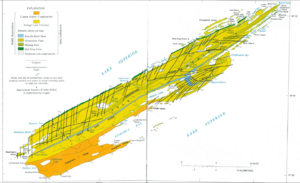
The island is mostly made of long ridges that run from southwest to northeast. The main ridge, Greenstone Ridge, is over 1,000 feet (300 m) high in many places. You can find greenstones, which are rounded stones of a mineral called chlorastrolite, near the lake. Chlorastrolite is the official state gem of Michigan!
The rocks on the island are very old. They are mainly from volcanic eruptions and ancient sediments. Glaciers also shaped the island. They carved out the valleys and ridges we see today.
Sometimes, small amounts of naturally occurring mercury are found with copper in the rocks. You can also find other beautiful gemstones like prehnite and agate on the island.
Fun Things to Do on Isle Royale
Isle Royale is a great place for outdoor activities! You can enjoy hiking, backpacking, fishing, boating, canoeing, kayaking, and watching nature. Remember, no cars or bikes are allowed, but wheelchairs are fine.
Hiking Adventures
The island has about 170 miles (274 km) of hiking trails. You can go for a short day hike or a long two-week trip around the island. Some trails are quite challenging with steep hills.
The Greenstone Ridge Trail is the longest trail in the park. It runs for 40 miles (64 km) from one end of the island to the other. Most people take 4 or 5 days to hike it. A boat shuttle can take hikers back to their starting point. The trail goes to the top of Mount Desor, the highest point on the island. You'll see wild forests, lakes, swamps, and beautiful shorelines.
Besides hiking, you can also go canoeing or kayaking. Many routes involve carrying your boat between different bodies of water.
Park Services and Camping
The park has two main developed areas:
- Ozaagaateng (formerly Windigo): This is at the southwest end of the island. Ferries from Minnesota arrive here. It has a camp store, showers, campsites, small cabins, and a boat dock.
- Rock Harbor: This is on the south side of the northeast end. Ferries from Michigan arrive here. It has a camp store, showers, a restaurant, a lodge, campsites, and a boat dock. If you don't want to camp, you can stay at the lodge in Rock Harbor or the cabins in Ozaagaateng.
Camping in the Wild
The park has 36 wilderness campgrounds. Some are deep inside the island and can only be reached by hiking or by canoe/kayak on the inland lakes. Others are only reachable by private boat.
Campsites often have three-sided wooden shelters with screens, floors, and roofs. There are also spots for pitching tents. Some larger tent sites are available for groups.
The campgrounds have basic facilities like pit toilets and picnic tables. Campfires are not allowed at most campgrounds, so you should use a gas or alcohol stove. You need to get drinking water from the lakes and filter or boil it to make it safe.
You can't hunt in the park, but you can fish. You can also pick edible berries like blueberries and thimbleberries along the trails.
Getting to Isle Royale
You can reach the park by ferries, floatplanes, and passenger ships during the summer. These leave from Houghton and Copper Harbor in Michigan, and Grand Portage in Minnesota. Private boats also travel to the island. Many people visit for a day trip on private boats or special day-trip ferries.
Isle Royale is the only American national park that closes completely in winter. It's closed from November 1 to April 15 because of extreme weather. This, along with the distance across Lake Superior, makes it the least-visited national park in the contiguous United States.
Ferry Services
Scheduled ferries run from Grand Portage, Copper Harbor, and Houghton.
The ferries from Grand Portage take about 1.5 hours to reach the island. They stay for 4 hours, giving you time to hike or join a park program.
The Isle Royale Queen IV leaves from Copper Harbor, Michigan. It arrives at Rock Harbor in 3 to 3.5 hours. It stays for 3.5 hours before returning.
The Sea Hunter also leaves from Grand Portage. It's the fastest ferry, taking 1.5 hours. It offers day trips to the Ozaagaateng visitor center. It can also carry kayaks and canoes.
The Ranger III is a large ship run by the National Park Service. It travels from Houghton, Michigan, to Rock Harbor. It takes 6 hours to get to the park. It can carry 125 passengers, canoes, kayaks, and even small powerboats. It makes two round trips each week from June to mid-September.
The Voyageur II, from Grand Portage, travels up to three times a week. It stays overnight at Rock Harbor and helps transport campers between lakeside campgrounds. It also carries kayaks and canoes. Hikers often use it to travel one way across the island and then hike back.
See also
 In Spanish: Parque nacional Isle Royale para niños
In Spanish: Parque nacional Isle Royale para niños


